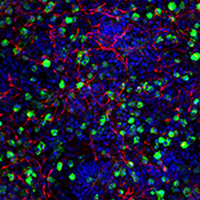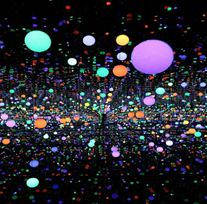If I were a neuron...
- Daniela Enache

- Apr 7, 2020
- 4 min read
A few months ago, I saw one of Yayoi Kusama’s installations, Gleaming Lights of the Souls. It is part of the permanent collection of the Louisiana Museum of Modern Art in Copenhagen.
Today such a normal gallery visit feels like a treat that we will miss for a long time, due to the world-wide coronavirus lockdown. So, I thought it was the right time to write about it — to remember the emotions and the thoughts that I experienced at that time.
And to offer some reading material that was not on coronavirus.
I was in a small room surrounded by mirrors, the reflecting water of the floor and hundreds of lamps hanging from the ceiling. The lamps are changing their colours adding to the extraordinary experience.
I looked at my own reflection and explored this new universe in relation to my own interior one. My everyday exterior environment was hectic and my interior one, shaken.
For a second, I thought about me as if I were a neuron in the brain of a person suffering with depression surrounded by hundreds and thousands of other cells like microglia, astrocytes and oligodendrocytes.
All these cells spoil me, the neuron.
They talk perfectly with each other, interact with each other to protect me, feed me, cleaning ecologically after me and in many ways providing for me, the neuron.

Besides neurons, there are other cells in the brain which are called glial cells. These cells are microglia, astrocytes and oligodendrocytes. Microglia is mainly involved in removing the aggressive agents. It can ingest these agents and produce inflammatory signals to call other microglia cells to help with the elimination of the agents.
Astrocytes are star-shaped cells which play several roles, including to provide nutrients (food) to the neurons, to repair after an injury to neurons, to control the blood flow to the neurons, even to produce inflammatory signals.
Oligodendrocytes are mainly responsible to produce the myelin sheaths, a substance which surround the axons of the neurons to insulate them.
A. Neurons are in blue, microglia in green and astrocytes in red. Photography from Neurofit, Preclinical Research for CNS and PNS disorders
B. Another Infinity Mirror Room of Yayoi Kusama entitled Brilliance of the Souls. Photography from Museum of Modern and Contemporary Art (Museum MACAN), Jakarta, Indonesia
The crosstalk between microglia and other glial cells such as astrocytes and oligodendrocytes is essential in the protection of the neurons.
What if in Kusama’s installation suddenly, the red colour gets slightly too bright disturbing my experience?
What if the microglia become too active and I, the neuron, am exposed to sustained abnormal levels of inflammation?
How will the other cells react to this new environment?
Researchers try to understand how other cells in the brain communicate with themselves and provide the best surviving environment for the neurons.
Thanks to many individuals suffering with depression who volunteer for research, a lot of studies are available on the role of different cells in the brain during a depressive episode.
It seems that microglia are more active but are not increased numerically. This increased activity leads to a slightly increased and persistent production of inflammatory markers, which are responsible for recruiting more inflammatory markers from the body into the brain.
In this environment, the astrocytes reduce their number, but not necessarily their function. So, the astrocytes continue to do their job in cleaning, feeding, maintaining the wellbeing of the neurons, but there are fewer of them able to do it. The number of oligodendrocytes is also reduced, mainly in the frontal lobe (key areas of the brain involved in depression).

And then what happens to me, the neuron, the spoiled cell in the brain?
A lot of questions remain unanswered. But it looks difficult to communicate with other neurons when you are living in a persistently inflamed environment.
Neurons are susceptible to increased levels of toxins and reduced number of substances which support the growth, survival and differentiation of neurons. There are fewer synapses, places where neurons meet and exchange information between themselves.
In this way high levels of inflammation may play a crucial role in initiating, maintaining and spreading the disease.
Depression might begin in the brain and become a more systemic disease, later affecting your entire body and your everyday life.
I, the observer of one of Yayoi Kusama’s infinity rooms, enjoyed the beauty of the installation together with my anxiety and sadness. Together we explored the feeling of infinite. It was difficult to concentrate and focus on the experience at some time. Ruminating thoughts invaded my mind.
The art experience is influences by our mood and probably by the level of inflammation in our brain.
Now, please have a close look at the picture below. Do you see the little snail? That’s pretty much me. I live in a wonderful world which I explore with curiosity and anxiety. I am curious and fascinated by its beauty, whilst also anxious to hurt its perfection.
I make a living working as a trainee psychiatrist and occasionally as a researcher on depression and Alzheimer’s disease. Art and nature help me in my struggle to be authentic and honest with myself and my surroundings.


HEADER










